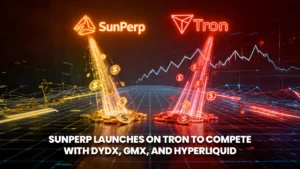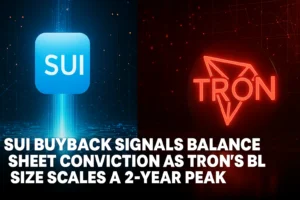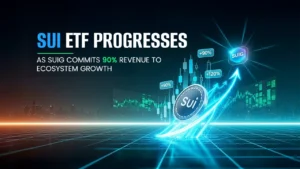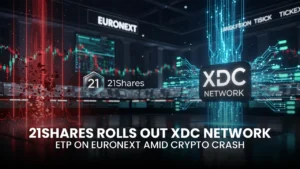eToro Onboards XDC as Circle Anchors USDC Settlement for Global Trade Finance
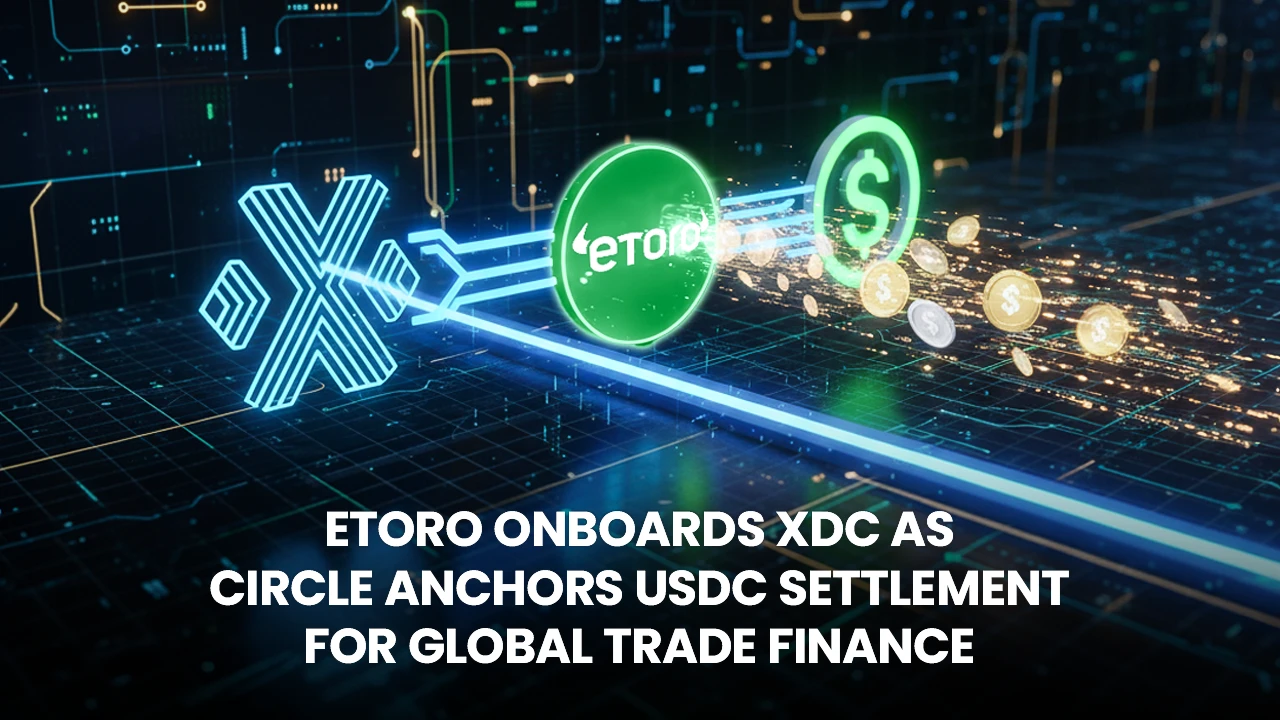
The XDC Network is pushing deeper into mainstream and institutional finance. In mid-September 2025, eToro added XDC to its crypto lineup, offering regulated retail access on a global platform known for converting watchers into buyers.
- eToro Listing Extends Regulated Retail Access
- USDC And CCTP V2 Create An On-Chain Settlement Layer
- Enterprise Features Align With Trade Finance Needs
- Tokenization Pipeline Is Filling: VERT Capital And Regulated Real Estate
- Market Access Vehicles Multiply In Europe
- Adoption Trends And Onchain Activity
- Signals From Teams And Partners
- Key XDC Milestones And Metrics In 2025
- Why The Combination Matters For Liquidity
- Risk Checks And What To Watch
- Conclusion
- Frequently Asked Questions About XDC, eToro, and USDC
- Is XDC listed on eToro now?
- What is changing with USDC on XDC?
- How fast and cheap are transactions on XDC?
- What evidence is there of real tokenization on XDC?
- Where can European investors get regulated exposure?
- How is adoption trending on-chain?
- Does XDC use Delegated Proof of Stake?
- What does CCTP V2 change for businesses?
- Who are the notable institutional partners in XDC’s orbit?
- What should investors watch next?
- Glossary of Key Terms
Weeks earlier, Circle confirmed that USDC and CCTP V2 are coming to XDC, positioning a regulated digital dollar as the core settlement asset for tokenized trade finance and real world assets across the network’s partners.
Built on a Delegated Proof of Stake framework that emphasizes efficiency and predictable performance, XDC is aligning technical design with enterprise needs. Together, the listing and the stablecoin integration tighten the link between retail liquidity and enterprise-grade settlement.
ALSO READ: Sui Links Up with Bitkub as Thailand Pushes Web3 Education and Scale
eToro Listing Extends Regulated Retail Access
CoinChapter reported that eToro has listed XDC, a move that broadens distribution to millions of users who prefer a regulated, familiar interface for buying new assets. For XDC, a network that has spent two years cultivating trade finance and tokenization use cases, visibility on a mainstream broker is more than a marketing line. It is a pipeline for incremental liquidity and a signal that the asset is enterprise-focused but retail accessible. The CoinChapter report places the update on September 17, 2025.
That timing matters. It lands alongside a stretch of ecosystem headlines that tie XDC to regulated settlement, regulated exchange-traded products, and regulated tokenization programs. Add them up and you get a flywheel effect that can help the network convert attention into transactions, and transactions into sustained usage.
USDC And CCTP V2 Create An On-Chain Settlement Layer
The missing piece for many tokenization programs has been a trusted, liquid, fully reserved digital dollar that institutions will actually use for settlement. Circle’s USDC, plus the Cross Chain Transfer Protocol V2, is that piece on XDC. The integration gives applications a compliant settlement currency and cross-chain mobility, while tapping Circle Mint and other on and off-ramps that treasury teams already understand. Cointelegraph’s summary puts it directly in the context of trade finance and RWA workflows.
Circle’s CCTP V2 enables native USDC transfers between XDC and other supported networks, such as Ethereum and Solana. For developers, that reduces the need for wrapped tokens and lowers bridge risk.
For corporate users, it can simplify cross-chain liquidity management and treasury operations, which are critical if invoices, credit notes, and receivables are going to move at scale.
Enterprise Features Align With Trade Finance Needs
The integration rides on XDC’s existing technical profile. Cointelegraph highlights throughput above 2,000 transactions per second, near-zero fees, roughly six-second finality, and compatibility with ISO 20022 messaging.
Those are the kinds of metrics enterprise teams test first because they map to cost, speed, and back office fit. The article also notes an ecosystem of over 175 applications and partners built around trade finance.
This is where the broader market conversation about Delegated Proof of Stake becomes relevant without turning into a textbook. Delegated Proof of Stake, often shortened to DPoS, is widely associated with networks that aim for high throughput, low cost, and predictable finality.
Enterprises looking at settlement layers tend to ask for those traits. Even if they do not ask about consensus mechanics by name, they want the performance profile that DPoS-style designs often target. That is the same performance profile Cointelegraph attributes to XDC’s current stack.
Tokenization Pipeline Is Filling: VERT Capital And Regulated Real Estate
In July, CoinDesk reported that Brazil’s VERT Capital plans to tokenize up to 1 billion dollars in corporate debt, agribusiness receivables, and related credit on XDC over the next 30 months. The deal underscores how tokenization is moving from pilots to structured finance, with Brazil emerging as a regional hub. VERT’s clients include blue-chip names in food and energy, aligning the project with real issuance and regulated oversight.
Separately, a regulated tokenized commercial real estate financing transaction was recently completed with Archax, VerseProp, Spitfire, and Daizun on XDC. Archax detailed the collaboration in August, framing it as a milestone in institutional tokenized finance with a regulated venue involved in issuance and lifecycle management. These are the kinds of reference deals enterprises watch to validate custody, compliance, and secondary trading.
Delegated Proof of Stake gets a nod here for a practical reason. When asset managers think about tokenizing receivables or financing real estate, throughput, fees, and finality translate directly into issuance economics and investor experience.
DPoS-oriented designs are often chosen to strike that balance. The bigger story is that institutional tokenization requires a stable settlement asset and compliant rails; USDC on XDC addresses the settlement side while regulated partners address issuance and trading.
ALSO READ: Sui Buyback Signals Balance Sheet Conviction as Tron’s Block Size Scales a 2-Year Peak
Market Access Vehicles Multiply In Europe
European investors can already access XDC exposure through the 21Shares XDC Network ETP under ticker XDCN. The product listed on SIX Swiss Exchange in August after going live on Euronext in July, giving investors a regulated wrapper that tracks XDC.
21Shares’ product page confirms the instrument and provides the ISIN. For a network pursuing enterprise adoption, these regulated vehicles complement exchange listings by widening distribution across brokerages.
The practical effect is convergence. Retail discovery happens on platforms like eToro, while institutional strategies that require mandates and wrappers can route through ETPs. That creates a broader surface area for price discovery and capital formation.
Adoption Trends And Onchain Activity
CoinChapter’s reporting adds texture. The number of unique wallet addresses on XDC rose by 36.7 percent in six months, from 1.13 million in February to 1.55 million in August. The network also rolled out EO Oracle Feeds aimed at real-world asset data, and partnered with Gam3s.gg to support low cost gaming transactions. Those updates show how enterprise themes and consumer apps can reinforce each other on the same settlement layer.
As the network’s trade finance posture grows, DPoS keeps showing up as a design pattern people recognize. Delegated Proof of Stake is discussed broadly in enterprise circles because it tends to support low fees and consistent finality. In other words, it targets predictable performance that can make invoice flows, receivable sales, and coupon payments feel routine instead of experimental. That is exactly what on-chain trade finance needs.
Signals From Teams And Partners
Two recent posts from official channels capture how the integration is being framed and why it matters for builders and institutions:
USDC and CCTP V2 are coming to XDC. From cross-chain to supply chain. Posted by XDC Foundation on August 27, 2025:
From cross-chain to supply chain.
USDC, issued by regulated affiliates of @Circle, is coming to XDC Network, alongside CCTP V2.
Here’s what it means 🧵 pic.twitter.com/wVjJr9BAtX
— XDC Foundation (@XDCFoundation) August 27, 2025
Circle is set to bring USDC and CCTP V2 to the XDC Network. Posted by XDC Foundation on September 1, 2025:
@Circle is set to bring @USDC, the world’s largest regulated stablecoin, and CCTP V2 to XDC Network.
USDC will power applications from RWA tokenization and global trade finance to DeFi and beyond.https://t.co/uIuksJ3dpF pic.twitter.com/psBeVX3xg7
— XDC Foundation (@XDCFoundation) September 1, 2025
The eToro listing also drew attention across community trackers and analysts, reinforcing that the exchange exposure is live for retail users. That conversation complements the official announcements by signaling where real buyers can act.
Key XDC Milestones And Metrics In 2025
| Date | Milestone or metric | Detail |
| Jul 30, 2025 | Tokenization program | VERT Capital to tokenize up to 1 billion dollars in debt and receivables on XDC over 30 months |
| Aug 2025 | Stablecoin plan | Circle to bring USDC and CCTP V2 to XDC Network |
| Aug 2025 | European ETP | 21Shares XDCN listed on SIX Swiss Exchange; earlier Euronext debut in July |
| Aug 7, 2025 | Real estate financing | Regulated tokenized commercial real estate financing completed with Archax, VerseProp, Spitfire, Daizun on XDC |
| Feb to Aug 2025 | Wallet growth | Unique addresses up 36.7 percent from 1.13 million to 1.55 million |
| Sep 17, 2025 | Exchange listing | eToro lists XDC for global retail access |
| Ongoing | Throughput and finality | 2,000 plus TPS, near-zero fees, around six-second finality; ISO 20022 compatibility |
These headline items point to a network that is trying to make enterprise settlement feel routine while keeping consumer use cases cheap. The combination is how tokenization reaches scale.
Why The Combination Matters For Liquidity
USDC gives XDC a widely used, regulated unit of account for on-chain invoices, receivables, and redemptions. CCTP V2 adds a native bridge for that unit to move across chains without extra wrapping steps that compliance teams dislike.
The eToro listing, for its part, is a distribution win that adds a new channel for inflows. When you connect those dots to the ETP market in Europe, you can imagine institutional and retail capital finding the same asset through different pipes.
This is also where Delegated Proof of Stake appears in boardroom conversations. A DPoS-style approach is often discussed as a way to match cost and speed with predictable finality. When settlement is denominated in USDC and clears quickly, corporate users start to treat the rails like any other service layer. That familiarity is a precondition for real issuance volume.
ALSO READ: Ark Invest Diversifies Exposure: Sells Tempus AI; Buys Amazon, Figma, and Bullish Shares
Risk Checks And What To Watch
Nothing in enterprise adoption is automatic. The next step for XDC will be converting announced integrations and partnerships into measurable issuance and settlement volume. The VERT Capital plan has a 30-month runway, and the real estate financing deal provides an example of regulated issuance.
Investors will be watching for on-chain proof points such as monthly growth in tokenized instruments, redemptions processed, and secondary trading activity. The network’s throughput and fee data points are positiv,e but will need to hold under load if volumes scale.
At the access layer, broker listings and ETPs help widen distribution but do not change fundamental demand by themselves. Adoption depends on useful applications. Here again, a stable settlement asset and enterprise-ready plumbing are the right building blocks. USDC on XDC is designed to address that, and partners working in regulated venues give those applications somewhere to land.
Conclusion
In September, eToro added XDC, giving the network a fresh retail onramp. In August, Circle set USDC and CCTP V2 on a path to XDC, supplying a regulated settlement currency with native cross-chain movement. Those updates slot into a summer of enterprise signals, including a $1 billion tokenization plan in Brazil and a regulated real estate financing transaction with Archax and partners.
Throughput, finality, and ISO 20022 compatibility support the enterprise pitch, while European ETPs and retail listings expand distribution. The through line is simple. Regulated dollars plus regulated market access plus credible issuance partners can push tokenized trade finance from headlines to daily workflows. For teams evaluating consensus choices, Delegated Proof of Stake remains part of the conversation because DPoS designs often chase the same goals enterprises want: speed, low cost, and predictability.
Frequently Asked Questions About XDC, eToro, and USDC
Is XDC listed on eToro now?
Yes. CoinChapter reported that eToro listed XDC on September 17, 2025, expanding regulated retail access.
What is changing with USDC on XDC?
Circle’s USDC and CCTP V2 are coming to XDC, enabling regulated dollar settlement and native cross-chain transfers of USDC between XDC and other supported chains.
How fast and cheap are transactions on XDC?
Cointelegraph cites more than 2,000 transactions per second, near-zero fees, and around six-second finality, along with ISO 20022 compatibility.
What evidence is there of real tokenization on XDC?
Brazil’s VERT Capital plans to tokenize up to 1 billion dollars in debt and receivables on XDC. A regulated tokenized commercial real estate financing deal was completed with Archax and partners.
Where can European investors get regulated exposure?
21Shares lists the XDCN ETP on SIX Swiss Exchange and Euronext, giving portfolio managers a wrapper that tracks XDC.
How is adoption trending on-chain?
CoinChapter reports that unique wallet addresses rose by 36.7 percent in six months, from 1.13 million in February to 1.55 million in August.
Does XDC use Delegated Proof of Stake?
This article does not make a claim about XDC’s specific consensus. It references Delegated Proof of Stake and DPoS in general terms because enterprises often look for performance traits associated with those designs, such as low fees and predictable finality. The performance metrics cited for XDC come from Cointelegraph.
What does CCTP V2 change for businesses?
It allows native USDC movement across chains, reducing reliance on wrapped tokens and helping treasury teams manage cross-chain liquidity more safely.
Who are the notable institutional partners in XDC’s orbit?
Cointelegraph references partnerships tied to trade finance initiatives and mentions an ecosystem of more than 175 applications and partners.
What should investors watch next?
Watch for growth in issued and redeemed tokenized instruments, more regulated deals on platforms like Archax, and sustained usage following the eToro listing and the USDC integration.
Glossary of Key Terms
- Stablecoin: A crypto asset designed to keep a steady value, often pegged to the U.S. dollar.
- CCTP V2: Circle’s protocol that enables native USDC transfers across supported blockchains.
- ISO 20022: A global financial messaging standard used by banks and payment networks.
- Tokenization: Converting rights to an asset into a digital token recorded on a blockchain.
- Real-world assets: Financial or physical assets like receivables, credit, or real estate represented on-chain.
- Settlement layer: The infrastructure where transactions finalize and funds move.
- ETP: Exchange-traded product that provides regulated exposure to an underlying asset.
- Liquidity: The ability to buy or sell an asset quickly without moving the price much.
- Finality: The point at which a transaction is considered irreversible on a blockchain.
- Delegated Proof of Stake: A consensus approach where token holders delegate validation to elected nodes; commonly shortened to DPoS.

